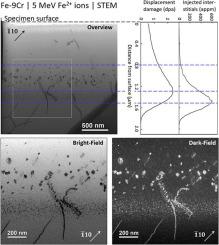Nuclear Materials and Energy ( IF 2.6 ) Pub Date : 2021-04-27 , DOI: 10.1016/j.nme.2021.101007 K. Vogel , P. Chekhonin , C. Kaden , M. Hernández-Mayoral , S. Akhmadaliev , F. Bergner

|
It is generally accepted that the microstructure of ion-irradiated Fe-based alloys does not only depend on the local level of displacement damage and the initial microstructure. Other factors such as the vicinity of a surface and the injected ions also play a role and may give rise to peculiar depth dependencies of the irradiated microstructure. Some investigators reported a band-like appearance indicating depth ranges of relatively uniform microstructure clearly distinguished from other ranges. Clarification is important for at least two purposes: first, to identify a depth range suitable for gaining meaningful information about the behaviour of materials exposed to neutron irradiation and, second, to correctly interpret results obtained by methods, such as nanoindentation, that integrate over extended depth ranges. A variation of the ion energy is expected to gain additional insight. In this work, two samples of Fe-9%Cr were irradiated at 300 °C with Fe2+ ions, one sample using 1 MeV ions and another sample using 5 MeV ions. Calculations using the binary collision code SRIM indicate displacement damage peaks at depths of 0.3 and 1.3 µm for ion energies of 1 and 5 MeV, respectively. The depth distribution of irradiation-induced dislocation loops was studied by cross-sectional scanning transmission electron microscopy (STEM). Loops visible in the STEM images were found to be arranged within two bands with the positions of these bands depending on the profiles of displacement damage and injected interstitials. The first and second band exhibit noticeably different number densities and mean sizes of the loops. For the 5 MeV irradiation, an extended range between the sample surface and the first band was observed, where decoration of preexisting line dislocations with loops is dominant. This microstructure resembles cases reported for neutron irradiation. For the 1 MeV irradiation, such a range does not exist. Estimates characterizing the loop size and number density in the distinct depth ranges are provided.
中文翻译:

Fe离子辐照的Fe-9Cr模型合金中辐照位错环的深度分布:离子能量的影响
通常认为,离子辐照的铁基合金的微观结构不仅取决于位移损伤的局部水平和初始微观结构。其他因素(例如表面附近和注入的离子)也起着作用,并且可能引起被辐照的微结构的特殊深度依赖性。一些研究者报告出现了带状外观,表明相对均匀的微观结构的深度范围明显不同于其他范围。澄清对于至少两个目的很重要:首先,确定适合获取有关暴露于中子辐射的材料的行为的有意义信息的深度范围;其次,正确解释通过纳米压痕等方法获得的结果,该方法在扩展的范围内进行积分深度范围。离子能量的变化有望获得更多的见解。在这项工作中,在300°C下用Fe辐照了两个Fe-9%Cr样品2+离子,一个样品使用1 MeV离子,另一个样品使用5 MeV离子。使用二进制碰撞代码SRIM进行的计算表明,离子能量分别为1和5 MeV时,在0.3和1.3 µm深度处的位移破坏峰值。通过截面扫描透射电子显微镜(STEM)研究了辐照引起的位错环的深度分布。发现在STEM图像中可见的环在两个频带内排列,这些频带的位置取决于位移损伤和注入的间隙的轮廓。第一和第二频带显示出明显不同的环数密度和平均大小。对于5 MeV辐照,观察到样品表面和第一个谱带之间的扩展范围,其中主要是利用环来装饰先前存在的线位错。这种微观结构类似于报道中子辐照的情况。对于1 MeV照射,不存在该范围。提供了在不同深度范围内表征环路尺寸和数量密度的估计值。


























 京公网安备 11010802027423号
京公网安备 11010802027423号